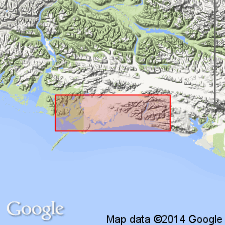
- Usage in publication:
-
- Redwood formation
- Modifications:
-
- Original reference
- Dominant lithology:
-
- Sandstone
- Conglomerate
- Shale
- AAPG geologic province:
-
- Alaska Southern region
Summary:
Pg. 770-782. Writer has divided Katalla formation of Martin into 2 conformable formations, largely on basis of lithology. There is no stratigraphic break between the 2 formations, but a decided change in lithology. The lower, 8,600+ feet thick, is here called Katalla formation; the upper, 5,100 feet thick, is here named Redwood formation. The Katalla occupies fully 85 percent of Katalla district; the Redwood is restricted to a broad, steeply plunging syncline between Redwood and Burls Creeks and to ridge between Cave and Hey Points. Fossils rare and as a rule poorly preserved, but the sediments (marine) are lithologically similar to the fossiliferous beds of Yakataga district, [Controller Bay region, southeastern Alaska], which are pronounced by B.L. Clark to be upper Oligocene, and they are here designated upper Oligocene. The Redwood formaiton is divided into 2 members: the upper (here named Puffy shale) consists of 4,000+ feet of shale with many thin sandstone layers and many shale-matrix conglomerates, in part of glacial origin; the lower (here named Point Hey sandstone) consists of 1,100 feet of sandstone and conglomerate with thin shale beds, and with heavy conglomerates at top. The Redwood formation overlies Katalla shales in Nichawak district, [Controller Bay region, southeastern Alaska].
[GNC remark (ca. 1936, US geologic names lexicon, USGS Bull. 896, p. 1791): See also Stilwater formation. The USGS classifies typical Katalla formation as Miocene(?).]
Source: US geologic names lexicon (USGS Bull. 896, p. 1790-1791).

- Usage in publication:
-
- Redwood Formation*
- Modifications:
-
- Adopted
- Age modified
- AAPG geologic province:
-
- Alaska Southern region
Summary:
Redwood Formation of Taliaferro (1932) adopted. Divided into (ascending) unnamed sandstone member (†Point Hey Sandstone Member of Taliaferro, 1932) and Puffy Member (now reassigned from Katalla). Conformably overlies Katalla Formation (now stratigraphically restricted). Age is Oligocene(?) and Miocene based on sparse fauna identified by F.S. MacNeil (written commun, 1963).
Typically developed and well exposed along crest of ridge between Puffy and Redwood Creeks [Katalla district, Controller Bay region, southeastern AK].
Source: GNU records (USGS DDS-6; Menlo GNULEX); Changes in stratigraphic nomenclature, 1976 (USGS Bull. 1435-A, p. A88).

- Usage in publication:
-
- Redwood Formation*
- Modifications:
-
- Age modified
- AAPG geologic province:
-
- Alaska Southern region
Summary:
Age is late Oligocene(?) through early Pliocene in Katalla area. [Shown in stratigraphic correlation chart of Gulf of Alaska margin, fig.4, p.244.]
Source: GNU records (USGS DDS-6; Menlo GNULEX).
For more information, please contact Nancy Stamm, Geologic Names Committee Secretary.
Asterisk (*) indicates published by U.S. Geological Survey authors.
"No current usage" (†) implies that a name has been abandoned or has fallen into disuse. Former usage and, if known, replacement name given in parentheses ( ).
Slash (/) indicates name conflicts with nomenclatural guidelines (CSN, 1933; ACSN, 1961, 1970; NACSN, 1983, 2005, 2021). May be explained within brackets ([ ]).

